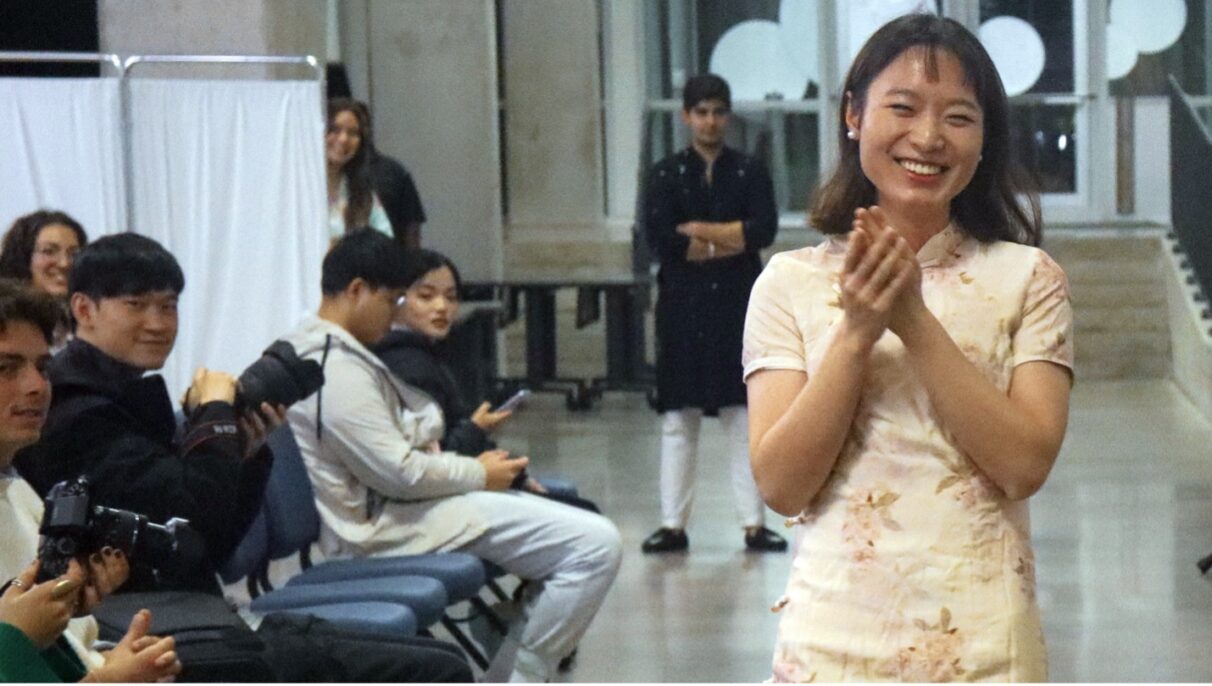Dalhousie caps off international week with a sustainable-fashion show
Students turn spotlight on ethical threads, upcycling and thrifting in runway celebration

caption
Gracie smiles at the audience as she struts the runway in her Yukata.A fashion show at Dalhousie University put sustainability at centre stage by showcasing how creativity and culture can intersect with environmental responsibility.
“Fashion’s not just an expression of style; it’s a powerful way to tell stories, showcase identity, and in this case, highlight sustainability,” said Alexa Goodman, a co-organizer of the International Education Week Fashion Show.
Goodman is sustainability manager with Dalhousie’s Office of Sustainability.

caption
Co-organizer Alexa Goodman struts the runway in a fully thrifted outfit. Her shoes were found on the side of the road!The late-November fashion show was also sponsored by the university’s international centre and the university’s student wellness initiative, Dal After Dark, which promotes substance-free programming.
Goodman said sustainability in fashion is important, pointing out that the industry is one of the largest contributors to environmental degradation, citing textile waste and excessive water usage as key concerns.

caption
Gracie struts the runway in a Yukata, a cotton summer kimono worn in casual settings such as summer festivals. It commonly features a multicoloured design.By opting for upcycled, reused, or thrifted clothing, she said, participants are reducing their environmental footprint and pushing back against the cycle of fast fashion.
Participants, all Dal student volunteers, made their own items for the fashion show using second-hand materials. The pieces were crafted as part of a collaboration with the Dal/Kings Craft Society, which provided resources and support to students as they repurposed and upcycled materials to create their unique outfits.

caption
Sarah (left) is wearing a kaftan. Adapted in various cultures, a traditional Moroccan kaftan for women is an elegant and ornate garment often crafted from luxurious materials like silk, velvet, or brocade. They are usually worn for formal events – like weddings and celebrations. Aya (right) is wearing traditional North African clothing, inspired by Amazigh (Berber) attire. It features vibrant colours, intricate embroidery, and symbolic accessories that celebrate North Africa’s indigenous heritage.The process involved selecting second-hand clothing or materials and participants used their creativity and craft skills to transform them into sustainable fashion pieces.
“It’s all about celebrating international education and bringing people together, and then from the sustainability side, just bringing light to the effects of fast fashion,” said co-organizer Nathan Barton, 22, a student at Dalhousie.

caption
Joy smiles as she struts the runway in a traditional Chinese dress commonly referred to as a Qipao. It is a form-fitting garment for women that originated in the early 20th century but is rooted in the traditional Manchu clothing of the Qing dynasty.“By choosing to purchase previously loved items, you’re giving them another chance to be worn, which reduces the pressure on purchasing new items,” Goodman said.
She also pointed out how the rising cost of living has made second-hand shopping more accessible, encouraging students to explore thrifting, clothing swaps, and even intergenerational hand-me-downs as ways to refresh wardrobes sustainably.

caption
One participant walks the runway wearing a Djellaba, a traditional North African robe with a hood. Djellabas are commonly worn in Morocco, Algeria, and Tunisia and are notable for their loose fit and pointed hood, called a qob. They are versatile and can be worn casually or for formal occasions, often depending on the fabric and design.About the author

Lindsay Catre
Lindsay Catre is a journalist and graduate student at the University of King’s College, where she is completing her Masters of Journalism....
